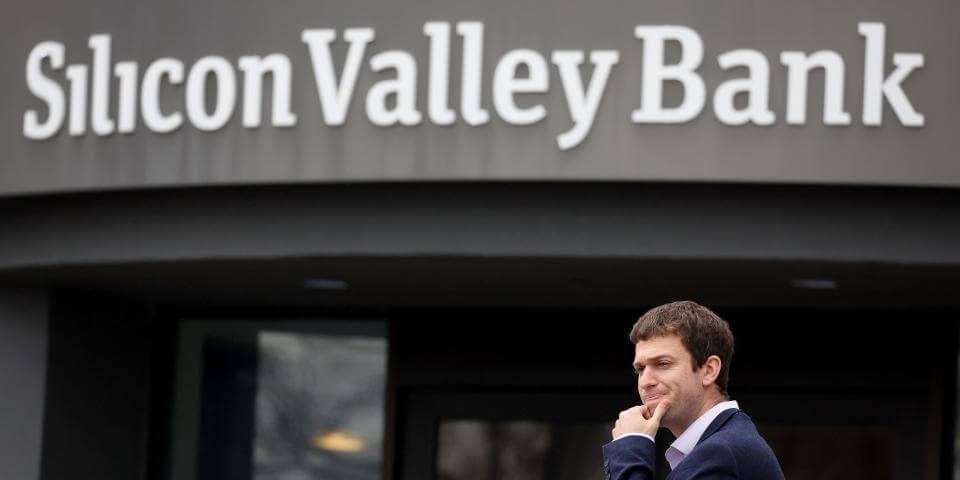The Fall of Silicon Valley Bank
Crisis SVB changes interest policies Central Banks
eyesonsuriname
Amsterdam, 12 March 2023– In early March, 40 chief financial officers from various technology groups gathered in Utah at the ski resort of Deer Valley for an annual “snow summit” hosted by Silicon Valley Bank, a crucial financial institution for start-ups.

Barely a week later, on Thursday morning, several of the finance chiefs were exchanging frantic messages about whether they should continue to hold their cash in the bank.
A sale by SVB of $20bn of securities to mitigate a steep drop in deposits had focused investors’ attention on vulnerabilities in its balance sheet.
They dumped its stock, wiping $10bn off its shares and crashing the market value of the bank — worth $44bn just 18 months earlier — to below $7bn.
“The dilemma was basically: I’m fine if they don’t draw their money. And they’re fine if I don’t draw mine,” said one of the CFOs, whose company had banked around $200mn with SVB.
But then some started to move. “I got a text from another friend — he was definitely moving his money to JPMorgan. It was happening,” he said.
“The social contract that we might have collectively had was too fragile.
I called our CEO and we wired 97 per cent of our deposits to another bank, HSBC, by midday on Thursday.”

By Friday morning, the bank was bust.
Customers had initiated withdrawals of $42bn in a single day — a quarter of the bank’s total deposits — and it was unable to meet the requests.
The Federal Deposit Insurance Corporation — the US bank regulator that guarantees deposits of up to $250,000 — moved into the bank’s Santa Clara, California, headquarters, declared it insolvent and took control.
The run was so swift its coffers were drained in full and carried a “negative cash balance” of nearly $1bn. The rapid collapse of SVB has stunned the venture capital and start-up community, many of whom now face uncertainty about the fate of their bank accounts and business operations.
SVB provided banking services to half of all venture-backed tech and life sciences companies in the US and played an outsized role in the life of entrepreneurs and their backers, managing personal finances, investing as a limited partner in venture funds and underwriting company listings.
“It turned out that one of the biggest risks to our business model was catering to a very tightly knit group of investors who exhibit herd-like mentalities,” said a senior executive at the bank.

“I mean, doesn’t that sound like a bank run waiting to happen?” SVB spectacularly unravelled in that bank run, but its fate had been sealed almost two years earlier. In 2021, at the height of an investment boom in private technology companies, SVB received a flood of money.
Companies receiving ever larger investments from venture funds ploughed the cash into the bank, which saw its deposits surge from $102bn to $189bn, leaving it awash in “excess liquidity”.
Searching for yield in an era of ultra-low interest rates, it ramped up investment in a $120bn portfolio of highly rated government-backed securities, $91bn of these in fixed-rate mortgage bonds carrying an average interest rate of just 1.64 per cent. While slightly higher than the meagre returns it could earn from short-term government debt, the investments locked the cash away for more than a decade and exposed it to losses if interest rates rose quickly.
When rates did rise sharply last year, the value of the portfolio fell by $15bn, an amount almost equal to SVB’s total capital. If it were forced to sell any of the bonds, it would risk becoming technically insolvent.

The investments represented a huge shift in strategy for SVB, which until 2018 had kept the vast majority of its excess cash in mortgage bonds maturing within one year, according to securities filings.
One person directly involved in the bank’s finances attributed the policy to a change of leadership within SVB’s key finance functions in 2017 as its assets marched towards $50bn, a threshold in which it would be labelled a “systemically important” lender subject to greater regulatory scrutiny.
The new financial leadership began to shift an ever greater percentage of excess cash into long-term fixed-rate bonds, a manoeuvre that would appease public shareholders by bolstering its overall profits, albeit only slightly.

But it appeared blind to the risk that cash pouring in was a symptom of low interest rates that could reverse if they rose. Central banks often increase rates to tamp overexuberance among investors, decisions that generally lead to a slowing of investment in speculative companies such as technology start-ups. SVB’s bond portfolio was exposed to rising rates and so too were its deposits. “We had enough risk in the business model.
You didn’t need risk in the asset/liability management profile,” said the former executive, referring to the bank’s ability to sell assets to meet its liquidity needs. “They missed that entirely.” As a venture capital investment bubble began to inflate in early 2021,

Nate Koppikar, a partner at hedge fund Orso Partners, began studying SVB as a way to bet against the industry at large.
“The problem with the business model is that when capital dries up, the deposits flee,” said Koppikar.
“It was one of the best ways to short the tech bubble.
The fact this bank failed shows that the bubble has burst.” While SVB bankers were entertaining finance chiefs in Utah early March, the pressure was rapidly mounting on SVB’s executive team, led by chief Greg Becker.
Although SVB’s deposits had been dropping for four straight quarters as tech valuations crashed from their pandemic-era highs, they plunged faster than expected in February and March. Becker and his finance team decided to liquidate almost all of the bank’s “available for sale” securities portfolio and to reinvest the proceeds in shorter-term assets that would earn higher interest rates and improve the pressure on its profitability.
The sale meant taking a $1.8bn hit, as the value of the securities had fallen since SVB had purchased them due to surging interest rates. To compensate for this, Becker arranged for a public offering of the bank’s shares, led by Goldman Sachs. It included a large investment from General Atlantic, which committed to buy $500mn of stock. The deal was announced on Wednesday night but by Thursday morning looked set to flop. SVB’s decision to sell the securities had surprised some investors and signalled to them that it had exhausted other avenues to raise cash.
By lunchtime, Silicon Valley financiers were receiving last-ditch calls from Goldman, which briefly attempted to put together a larger group of investors alongside General Atlantic to raise capital, as SVB’s share price was tanking.
At the same time, some large venture investors, including Peter Thiel’s Founders Fund, advised companies to pull their money from SVB.
Becker, in a series of calls with SVB’s customers and investors, told people not to panic. “If everyone is telling each other SVB is in trouble, that would be a challenge,” he said. Suddenly, the risk that had been building on SVB’s balance sheet for more than a year became a reality.
If deposits fell further, SVB would be forced to sell its held-to-maturity bond portfolio and recognise a $15bn loss, moving closer to insolvency. Rival bankers argued the plan was flawed from the outset — disclosing a $1.8bn loss at the same time as only securing $500mn of the $2.25bn capital raise from an anchor investor.

“You can’t build a book while the market is open and you’re telling people there’s a $2bn hole,” said one senior banker at a competitor. There was external pressure, too. Goldman bankers on the capital raise knew the deal was being done in a way that was hard to pull off with an unhelpful market backdrop.
But the company was facing a time crunch due to the downgrade by Moody’s to Baa1 from A3 on Wednesday. “Their hand was forced by the rating agency,” said one person involved in the capital raise. Goldman Sachs declined to comment. Recommended Richard Waters
With the collapse of Silicon Valley Bank, tech may lose a vital organ The scale and speed of the ensuing destruction has had a ripple effect on the technology industry globally.
As regulators attempt to salvage SVB’s assets and restore customer funds, potentially through a sale of some or all of the bank’s operations this weekend, the collapse has sparked scrutiny of its approach to risk management. Ultimately, it committed a cardinal sin in finance. It absorbed enormous risks with only a modest potential pay-off in order to bolster short-term profits.
One hedge fund short seller who detailed the bank’s risks last year warned that SVB had almost unwittingly built the foundation for what could become “the first large US bank collapse in 15 years”. “They went for an extra [0.4 percentage points] of yield and blew up the bank,” said the person, whose fund held a bet against SVB.
“It is really sad.”
eyesonsuriname









